1. "The Last Supper" by Leonardo da Vinci (1495-1498)
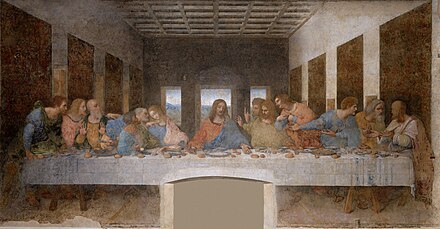
Image Courtesy: https://en.wikipedia.org/wiki/The_Last_Supper_(Leonardo)
2. Michelangelo's "The Creation of Adam", 1512
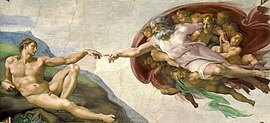
Image Courtesy: https://en.wikipedia.org/wiki/The_Creation_of_Adam
Michelangelo’s fresco “The Creation of Adam,” part of the Sistine Chapel's ceiling, is one of Renaissance art's masterpieces. The painting depicts the Biblical tale of God creating Adam in a touching gesture. Michelangelo’s depiction is celebrated for its anatomical accuracy and exploration of human condition and divine intervention.
3. Sandro Botticelli, "The Birth of Venus", circa 1485-1486
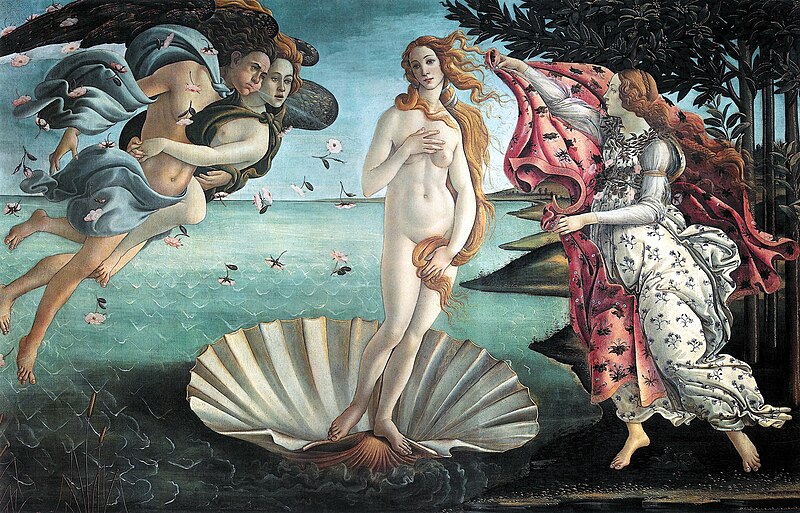
Botticelli’s "The Birth of Venus", while primarily a mythological work, has deep religious overtones that reflect Renaissance ideals of divine creation and beauty. The goddess Venus is depicted emerging from the ocean, symbolizing purity as well as divine love. The painting's composition and allegory have made it an important work within the context of Christian thought and classical thought.
4. "The Annunciation" by Leonardo da Vinci (c. 1472-1475)

Image Courtesy: https://en.wikipedia.org/wiki/Annunciation_(Leonardo)
5. Raphael's "The Transfiguratio", 1516-1520

Image Courtesy: https://en.wikipedia.org/wiki/Transfiguration_(Raphael)
Raphael’s "The Transfiguration", one of his final works, is a masterpiece from the High Renaissance. The painting shows Christ's moment of transfiguration, his divine form shining brightly in the background. Moses and Elijah are also present. Raphael shows off his mastery of conveying both spiritual and human elements in this composition that contrasts celestial and terrestrial realms.
6. Raphael's "School of Athens", 1509-1511

Image Courtesy: https://en.wikipedia.org/wiki/The_School_of_Athens
Raphael’s "The School of Athens", though primarily a work of philosophy, contains significant religious symbolism that reflects the Renaissance's integration of Christian and classical thought. The fresco depicts a grand architectural setting where philosophers and theologians debate knowledge. Plato and Aristotle are central figures, which symbolise the synthesis between faith and reason.7. Peter Paul Rubens, "The Descent from the Cross", 1612-1614
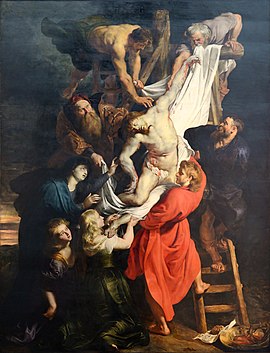
Image Courtesy: https://en.wikipedia.org/wiki/
The "Descent from the Cross", by Peter Paul Rubens, captures the momentous moment when Christ is taken down from the Cross. The painting is known as a work of art with a dynamic composition, emotional depth, and dynamic figures. Rubens' mastery in color and movement creates a powerful sense of reverence and grief.8. Hieronymus Bosch, "The Last Judgment", c. 1482
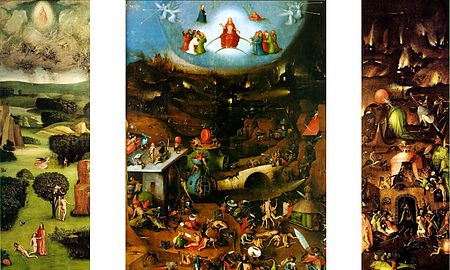
Image Courtesy: https://en.wikipedia.org/wiki/The_Last_Judgment_(Bosch,_Vienna)
Hieronymus' "The Last Judgment", a surreal and complex depiction, is the last judgment day. The elaborate and fantastical imagery in the painting of heaven and hell reflect Bosch's vision of spiritual and moral consequences. The scenes are richly detailed and invite the viewer to reflect on sin and redemption.
9. "The Adoration of the Magi", by Sandro Botticelli, (c.1482)
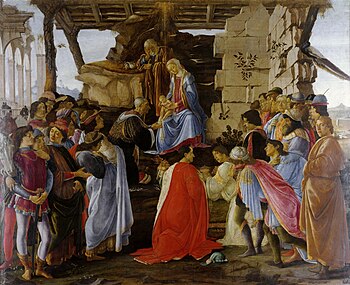
Image Courtesy: https://en.wikipedia.org/wiki/Adoration_of_the_Magi_(Botticelli,_1475)
Botticelli's painting "The Adoration of the Magi", depicts the moment the Magi give gifts to the baby Jesus. This painting is noted for its detailed figures and rich symbolism. It also includes contemporary figures of the Medici Family as the Magi. This work is a fusion of religious narrative and the political and social contexts of Renaissance Florence.
10. Fra Angelico's "The Coronation of Virgin" (c.1434-1444)

Image Courtesy: https://en.wikipedia.org/wiki/Coronation_of_the_Virgin_(Fra_Angelico,_Louvre)
11. Caravaggio, "The Sacrifice Of Isaac", 1603-1604
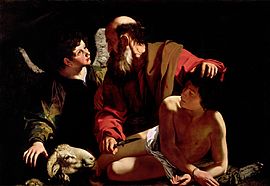
Image Courtesy: https://en.wikipedia.org/wiki/Sacrifice_of_Isaac_(Caravaggio)
Caravaggio’s "The Sacrifice Of Isaac" depicts a dramatic Biblical scene in which Abraham is about sacrifice his son Isaac. Caravaggio uses intense chiaroscuro to create a scene that is incredibly powerful.
12. Peter Paul Rubens, 1610-1611: "The Elevation of the Cross"
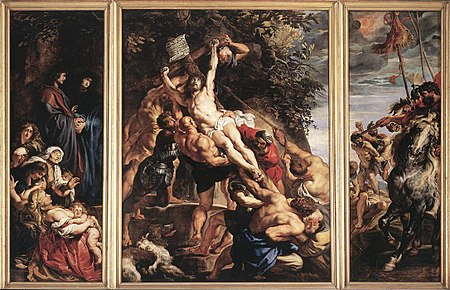
Image Courtesy: https://en.wikipedia.org/wiki/The_Elevation_of_the_Cross_(Rubens)
Rubens "The Elevation of the Cross", a dramatic portrayal of Christ on the cross, is an example of a Rubens work. The dynamic composition of the painting, the muscular figures and the emotional intensity in the crucifixion are all well-known. Rubens's use of light, shadow and movement enhances the sense of sacrifice and movement in this painting.
13. Michelangelo's "The Holy Family With the Infant Saint John The Baptist" (c. 1506).

Image Courtesy: https://www.wga.hu/html_m/m/michelan/2paintin/1/1doniton.html
Michelangelo’s "The Holy Family With the Infant Saint. John the Baptist" displays his mastery in anatomical accuracy and composition. This painting shows the Holy Family and the young John The Baptist. It highlights Michelangelo’s ability to convey tenderness and sanctity in this family and divine moment.
14. "The Flight into Egypt" by Giotto di Bondone (c. 1304-1306)
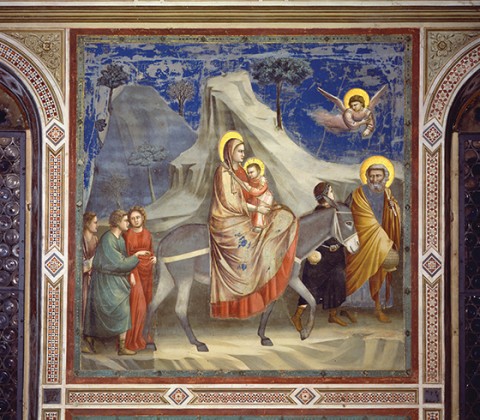
Image Courtesy: https://www.christiancentury.org/article/art/flight-egypt-giotto-di-bondone
The Holy Family escapes from Herod's massacre. Giotto fresco, "The Flight into Egypt", part of the Scrovegni Chapel Cycle. Giotto is praised for his emotional realism, narrative clarity and the way he depicts religious subjects.
15. Caravaggio (1603), "The Good Shepherd"

Image Courtesy: https://en.wikipedia.org/wiki/Adoration_of_the_Shepherds_(Caravaggio)
Caravaggio portrays Christ in "The Good Shepherd", as a benevolent, caring shepherd who cares for his sheep. Caravaggio is praised for the painting's realistic depiction of Christ, its symbolism of pastoral care and protection from God and his skill at combining religious themes with everyday reality.
16. Raphael's (1507) "The Mystical Marriage of Saint Catherine

Raphael’s "The Mystical Marriage of Saint Catherine", depicts Saint Catherine accepting a mystical marriage ring from Christ. The harmonious composition, the use of colors, and the delicate depiction of the divine meeting are all admired in this painting. Raphael’s attention to details and spiritual depth makes it a noteworthy work in the context religious art.
17. The Baptism Of Christ by Andrea del Verrocchio (c. 1475-1478)
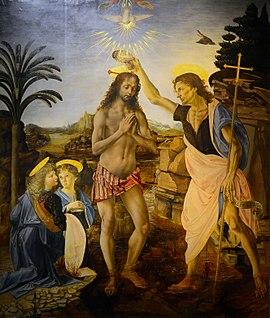
The Baptism of Christ, a work by Andrea del Verrocchio that includes contributions from a young Leonardo da Vinci is an important early Renaissance masterpiece. Leonardo's angel adds a touch of elegance to the painting, which depicts Christ's baptism.
18. Diego Velazquez, "The Crucifixion", 1632

Image Courtesy: https://en.wikipedia.org/wiki/Christ_Crucified_(Vel%C3%A1zquez)
Diego Velazquez’s "The Crucifixion", a powerful portrayal of Christ's death by crucifixion, is an important work. The painting is praised for its realistic depiction of the scene, emotional intensity of figures, and Velazquez’s mastery of capturing the somber, profound nature of this pivotal moment.
19. Rogier van den Weyden's "The Descent from the Cross", circa 1435-1440

Image Courtesy: https://en.wikipedia.org/wiki/The_Descent_from_the_Cross_(van_der_Weyden)
Rogier Van der Weyden’s "The Descent from the Cross", a powerful portrayal of Christ being removed from the cross, is an incredibly moving work. Van der Weyden is able to express deep religious feelings through his detailed and emotional depiction.
These 19 religious works represent a variety of artistic styles, historical periods and theological perspectives. Each painting captures spiritual and divine themes in its own unique way. It offers viewers a glimpse of the sacred and sublime. These masterpieces, from the Renaissance's grandeur and dramatic intensity to the early Christian's reverent simpleness, continue to inspire us and enhance our understanding of the role religious art plays in human culture.









